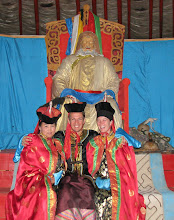Mongolian modern nomads

• Almost ¼ the population is nomadic.
•
Nomads move seasonally searching for optimal pasture and water for
their livestock. Moves typically occur at least four times a year
covering an average distancearound 50-200 km.
•
Mongolia has an immense richness in livestock; the five speciesanimals
are sheep, goats, camels, horses, and cattle. Nomad lifestyle is
closely connected to nature and the animals which produce milk, meat,
hides, wool and quality cashmere as well as transportation.
•
Horses are onethe most important animals for nomads. They are
semi-wild naturally, so they have to be broken by skilled horsemen.
•
Nomads live in the Mongolian Ger, a circular felt-covered dwelling,
still used by the majority Mongolians .The Ger is ideally suited to the
extreme weather conditions the country and the nomadic lifestyle.
• Gers can easily be assembled and dismantled with 1 hour and transported from one place to another and put up again.
• Today a large portion Mongolia's population lives in Gers, even in Ulaanbaatar city.
• There are many unique traditions and customs related to nomadic culture. Here you can see somethem:
Airag feast:
•
The Airag Feast, a festivalhorses and a symbolplentiful food, is an
important part Mongolian custom. Airag is fermented mare’s milk and is
the favorite thirst-quencher for Mongolian people.
•
A family that hosts the Airag Feast chooses a fine sunny day for the
beginning Airag season and prepares food and other necessary things for
the feast.
• The Airag Feast can
be made on the daycatching the mares or after the fermenting the mare’s
milk, depending on the region and people’s customs.
•
On the Feast Day neighboring families gather and bring with them their
diary products such as distilled Mongolian milk vodka, cheese, dried
curd and other homemade products.
•
After several customs are completed the feast starts at the
‘fieldhorses’ where plentiful milk products and boiled meat are placed
on the table. During the Airag Feast a blessing is made for good luck,
for nature, and for the wellbeing the local people.
Making felt, carpet and the coveringGer:
•
Felt is onethe two main components the Mongolian traditional dwelling
know as the Ger. There is a custom for making high quality and long
lasting felt.
• Felt making is a
Mongolian traditional craft and forms part Mongolian Culture. Felt is
made in autumn by processing sheep’s wool. A good day is chosen and
neighboring families and relatives are informed about the festive work.
• Felt makers choose the best
location with fine grass, and select the best quality wool. The next
stage involves rolling and tightly wrapping a cow hide around the wool.
It is then dragged by horse along the ground about 15-20 km for a full
day.
• After felt is completed,
locals celebrate with milk tea and abundant diary products like curds,
cheese, clotted cream, pastries, distilled vodka, fermented mare’s milk
and boiled mutton.
Compelling a Camel to Weep:
•
In the Gobi area in Mongolia, female camels sometimes reject their
offspring. If the two cannot be reunited, the baby camel may starve
without its mother’s milk.
• Specialized lyrical singing is used to persuade the mother to reaccept her baby.
•
Singing is performed at dawn and dusk, quietly and in a way that
mimicks the sounds a camel. Flutes and/or horse-head fiddles are used
for accompaniment.
• After listening to the song, tears appear in the female camel’s eyes and she is compelled to accept her offspring.
•
If the ritual does not work, other females can sometimes be compelled
to accept the orphaned camel by using the same process.


0 Comments:
Post a Comment
Subscribe to Post Comments [Atom]
<< Home